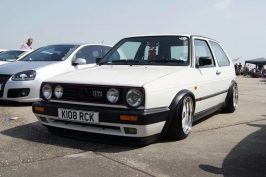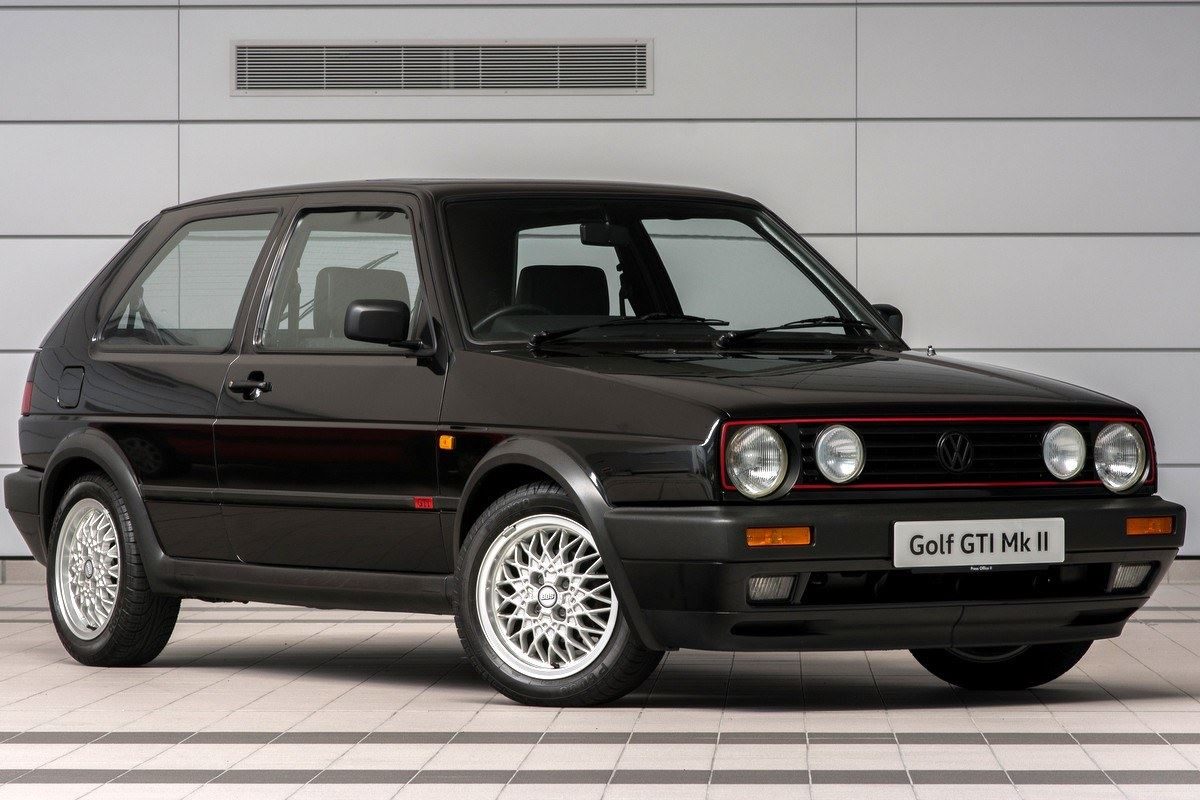- 171

- Longueuil
- SarquesCurseMark
The Golf Mk2 was available as a 3- and 5-door hatchback. Its sedan sister car (available as a 4- and a 2-door model) was again called Jetta. No cabriolet version was developed from the Mk2; instead, the Mk1-based convertible continued to be produced, with minor changes.Trim levels included base, C, CL and GL and initially a range-topping Carat model (until 1986), later a GT (in 1987) version was also on offer. In North America, there was only a base model until 1986, in 1987 a GL and GT model, in 1988-1989, there was all three, and in 1990 until the end of its run there was again only a GL. The GTI model existed from 1985–1987, and again from 1990–1992, and the GTI 16v existed from 1987–1992. In Japan the range consisted of catalysed Ci/CLi/GLi models all sharing the same 1.6 or later 1.8 liter fuel-injected I4 engines. In the course of the years, a host of "limited edition" models appeared on various markets, distinguished by cosmetic changes and/or an enriched features list. Generally, these were option packages on top of a base "model" (CL, GL, etc.).New base engine was a 1.05 litre inline four; other engine offerings included 1.3, 1.6 and 1.8 litre petrol fours and 1.6 litre naturally aspirated or turbocharged diesel engines. In North America, all Golf Mk2s had 1.8 liter petrol or 1.6 diesel engines (the GTI, while not a Golf model in North America, also had a 2.0 liter model).
Golf GTI & GTI 16v
The successful Golf GTI (or, in the USA, simply "GTI") was continued with the Mk2 as a sporty 3- or 5-door hatchback. Like late Mk1 GTIs, it featured a fuel-injected 1.8 litre four developing 112 PS (82 kW; 110 hp). In 1986 (1987 for North America) a Golf GTI 16V was introduced; here the 1.8 litre engine put out 139 PS (102 kW; 137 hp) (or 129 PS (95 kW; 127 hp) for the catalyst version) and the model was marked by discreet red and black "16v" badges front and rear. US/Canadian GTIs were later equipped with 2.0 16 valve-engines, available in the Passat and Corrado outside North America. In 1990, like the Golf, the GTI was given a facelift, and the "Big Bumper" became standard on all GTIs. This was maintained through the rest of the Mk2 model era. In 1990 the GTi G60 was also introduced featuring the 8v 1.8 with a G60 supercharger this version is not to be confused with the very rare G60 Limited (see below).
Golf Syncro
In February 1986, Volkswagen presented the first Golf with four-wheel drive. This Golf Syncro was available with the 1.8 engine only (90 PS (66 kW; 89 hp), later 98 PS (72 kW; 97 hp)). Its 4WD system had been developed in collaboration with Steyr-Daimler-Puch[4] of Austria, and featured a viscous coupling and flexible partition of torque between front and rear axle. Due to its high price (in 1986, a Syncro cost about 30% more than an equivalent front wheel drive model[5]) the model remained rare; from 1986 to 1989, for instance, just 26,000[6] Syncros were built.
Golf Limited
Based on the Rallye Golf, a very limited edition Golf Mk2 variant exists, combining all of the high-line options (Leather interior with heated and hight adjustable front seats,4 electric windows,electric mirrors,abs,power steering,sunroof etc..) available at the time. Designed and hand-built by the Volkswagen Motorsport division; only 71 of these "Golf Limited" models where produced. that makes them the most exclusive Volkswagen Golf ever builT. The exclusive feature package included a G60 supercharged version of the 16-valve(3-G motorcode!) engine, mated to a sports transmission and Syncro four-wheel drivemechanism, all cars where build in five doors because of the strength of a 5 door chassis (more angles), BBS RM012 wheels in 6.5Jx15", US bumpers, a plain two-headlight grille with a unique blue detail,and a VW Motorsport logo. black VW logo, Hella tinted taillights, motorsport badges and a special numbered plaque. In 1989, these cars cost in the region of DM 68,500[7] each and were primarily sold to VAG executives and management, although a few are known to exist in Britain as of 2005. These cars produced 210 PS (154 kW; 207 hp) 252 N·m (186 lb·ft) and 0–100 km/h (0-62 mph) in 7.2 seconds, making them the most powerful VW Golf ever produced until VW released the Mk4 R32 in 2001 with 241 PS (177 kW; 238 hp) in 2003.
Golf Country
There was also a version called Golf Country (3,000 cars), designed for light off-roaddriving. It had more suspension travel, four-wheel drive, bullbars (generally over a single headlight grille), a skid plate for protecting the engine area, and a spare wheel mounted externally on the back.In Europe, it was offered with the acclaimed 114 bhp (85 kW) 1.8 8v petrol engine. There were also: 160 "Country Allround"; 558 " Country - Chrompaket" with Chrome bullbars and beige leather interior; and 50 "Country GTI" for VW-staff. The Golf Country was particularly popular in Alpine regions in central Europe
Golf GTI & GTI 16v
The successful Golf GTI (or, in the USA, simply "GTI") was continued with the Mk2 as a sporty 3- or 5-door hatchback. Like late Mk1 GTIs, it featured a fuel-injected 1.8 litre four developing 112 PS (82 kW; 110 hp). In 1986 (1987 for North America) a Golf GTI 16V was introduced; here the 1.8 litre engine put out 139 PS (102 kW; 137 hp) (or 129 PS (95 kW; 127 hp) for the catalyst version) and the model was marked by discreet red and black "16v" badges front and rear. US/Canadian GTIs were later equipped with 2.0 16 valve-engines, available in the Passat and Corrado outside North America. In 1990, like the Golf, the GTI was given a facelift, and the "Big Bumper" became standard on all GTIs. This was maintained through the rest of the Mk2 model era. In 1990 the GTi G60 was also introduced featuring the 8v 1.8 with a G60 supercharger this version is not to be confused with the very rare G60 Limited (see below).
Golf Syncro
In February 1986, Volkswagen presented the first Golf with four-wheel drive. This Golf Syncro was available with the 1.8 engine only (90 PS (66 kW; 89 hp), later 98 PS (72 kW; 97 hp)). Its 4WD system had been developed in collaboration with Steyr-Daimler-Puch[4] of Austria, and featured a viscous coupling and flexible partition of torque between front and rear axle. Due to its high price (in 1986, a Syncro cost about 30% more than an equivalent front wheel drive model[5]) the model remained rare; from 1986 to 1989, for instance, just 26,000[6] Syncros were built.
Golf Limited
Based on the Rallye Golf, a very limited edition Golf Mk2 variant exists, combining all of the high-line options (Leather interior with heated and hight adjustable front seats,4 electric windows,electric mirrors,abs,power steering,sunroof etc..) available at the time. Designed and hand-built by the Volkswagen Motorsport division; only 71 of these "Golf Limited" models where produced. that makes them the most exclusive Volkswagen Golf ever builT. The exclusive feature package included a G60 supercharged version of the 16-valve(3-G motorcode!) engine, mated to a sports transmission and Syncro four-wheel drivemechanism, all cars where build in five doors because of the strength of a 5 door chassis (more angles), BBS RM012 wheels in 6.5Jx15", US bumpers, a plain two-headlight grille with a unique blue detail,and a VW Motorsport logo. black VW logo, Hella tinted taillights, motorsport badges and a special numbered plaque. In 1989, these cars cost in the region of DM 68,500[7] each and were primarily sold to VAG executives and management, although a few are known to exist in Britain as of 2005. These cars produced 210 PS (154 kW; 207 hp) 252 N·m (186 lb·ft) and 0–100 km/h (0-62 mph) in 7.2 seconds, making them the most powerful VW Golf ever produced until VW released the Mk4 R32 in 2001 with 241 PS (177 kW; 238 hp) in 2003.
Golf Country
There was also a version called Golf Country (3,000 cars), designed for light off-roaddriving. It had more suspension travel, four-wheel drive, bullbars (generally over a single headlight grille), a skid plate for protecting the engine area, and a spare wheel mounted externally on the back.In Europe, it was offered with the acclaimed 114 bhp (85 kW) 1.8 8v petrol engine. There were also: 160 "Country Allround"; 558 " Country - Chrompaket" with Chrome bullbars and beige leather interior; and 50 "Country GTI" for VW-staff. The Golf Country was particularly popular in Alpine regions in central Europe
Attachments
Last edited:





